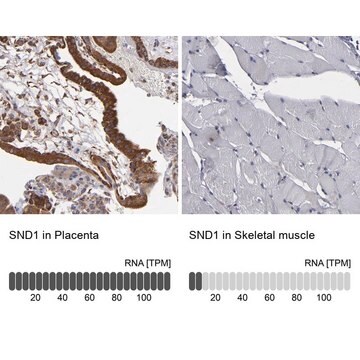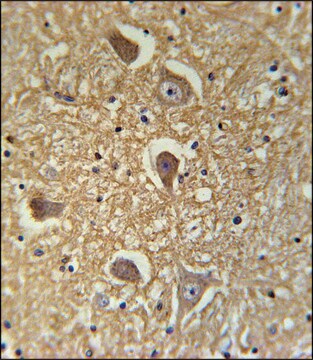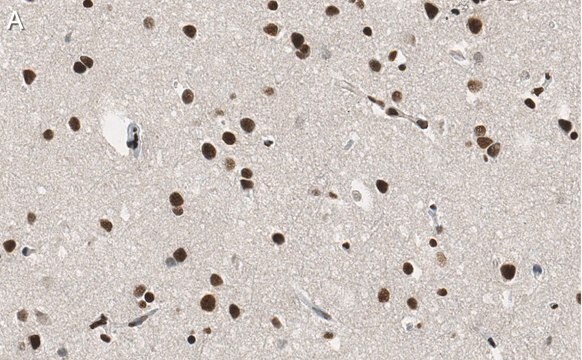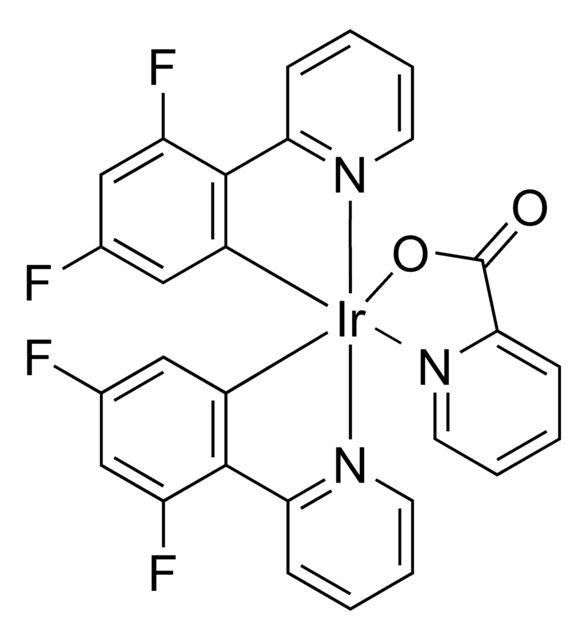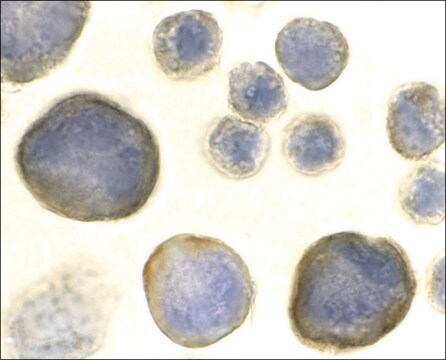SAB4200504
Anti-SND1 antibody, Mouse monoclonal
clone SND1-3, purified from hybridoma cell culture
同義詞:
Monoclonal Anti-SND1 antibody produced in mouse, Monoclonal Anti-TDRD11, Monoclonal Anti-staphylococcal nuclease and tudor domain containing 1, p100
登入查看組織和合約定價
全部照片(3)
About This Item
分類程式碼代碼:
12352203
NACRES:
NA.41
推薦產品
生物源
mouse
共軛
unconjugated
抗體表格
purified from hybridoma cell culture
抗體產品種類
primary antibodies
無性繁殖
SND1-3, monoclonal
形狀
buffered aqueous solution
分子量
antigen ~102 kDa
物種活性
human, rat, mouse
濃度
~1.0 mg/mL
技術
western blot: 1-2 μg/mL using whole extracts of human HeLa or HEK-293T cells.
同型
IgG1
UniProt登錄號
運輸包裝
dry ice
儲存溫度
−20°C
目標翻譯後修改
unmodified
基因資訊
human ... SND1(27044)
mouse ... Snd1(56463)
rat ... Snd1(64635)
一般說明
Monoclonal Anti-SND1 (mouse IgG1 isotype) is derived from the hybridoma SND1-3 produced by the fusion of mouse myeloma cells and splenocytes from BALB/c mice immunized with a synthetic peptide. The Staphylococcal nuclease and tudor domain containing 1 (SND1) protein is highly conserved from yeast to human. It contains five repeated staphylococcal nuclease-like domains and a tudor-like domain, probably required for its interaction with nucleic acids and proteins, respectively. The SND1 protein is a constituent of the RNA-induced silencing complex (RISC). The SND1 gene is mapped to the human chromosome location 7q31.3.
特異性
Monoclonal Anti-SND1 recognizes human, mouse, rat, hamster and bovine SND1.
免疫原
Synthetic peptide corresponding to an internal region of human SND1, conjugated to KLH. The corresponding sequence differs by a single amino acid in mouse and rat SND1.
應用
Monoclonal Anti-SND1 antibody produced in mouse may be used in:
- immunoblotting
- immunoprecipitation
- immunofluorescence
生化/生理作用
The Staphylococcal nuclease and tudor domain containing 1 (SND1) protein is involved in the regulation of transcription. It also modulates the RNA interference (RNAi) function, RNA splicing, editing and stability. The SND1 protein promotes the degradation of hyper-edited inosine containing miRNA precursors. It modulates miRNA processing and expression through RNA editing by adenosine deaminase acting on RNA (ADAR). SND1 is up-regulated in human colon cancer, breast cancer and cancer cell lines. This protein promotes nucleic acid interaction along with protein-protein interactions. It also interacts with transcription factors as a transcriptional co-activator of Epstein-Barr virus nuclear antigen 2 (EBNA2) and signal transducer and activator of transcription (STAT5 and STAT6).
外觀
0.01M 磷酸缓冲盐溶液,pH 7.4,含 15mM 叠氮化钠。
儲存和穩定性
For continuous use, store at 2-8°C for up to one month. For extended storage, freeze at -20oC in working aliquots. Repeated freezing and thawing,or storage in “frost-free” freezers,is not recommended. If slight turbidity occurs upon prolonged storage, clarify the solution by centrifugation before use. Working dilution samples should be discarded if not used within 12 hours.
免責聲明
Unless otherwise stated in our catalog or other company documentation accompanying the product(s), our products are intended for research use only and are not to be used for any other purpose, which includes but is not limited to, unauthorized commercial uses, in vitro diagnostic uses, ex vivo or in vivo therapeutic uses or any type of consumption or application to humans or animals.
未找到適合的產品?
試用我們的產品選擇工具.
儲存類別代碼
10 - Combustible liquids
閃點(°F)
Not applicable
閃點(°C)
Not applicable
分析證明 (COA)
輸入產品批次/批號來搜索 分析證明 (COA)。在產品’s標籤上找到批次和批號,寫有 ‘Lot’或‘Batch’.。
Hasiyet Memetimin et al.
Scientific reports, 12(1), 22291-22291 (2022-12-25)
Lipoprotein lipase (LPL) hydrolyzes the triglyceride core of lipoproteins and also functions as a bridge, allowing for lipoprotein and cholesterol uptake. Transgenic mice expressing LPL in adipose tissue under the control of the adiponectin promoter (AdipoQ-LPL) have improved glucose metabolism
Expression analysis of Tudor-SN protein in mouse tissues
Fashe T, et al.
Tissue & cell, 45(1), 21-31 (2013)
我們的科學家團隊在所有研究領域都有豐富的經驗,包括生命科學、材料科學、化學合成、色譜、分析等.
聯絡技術服務